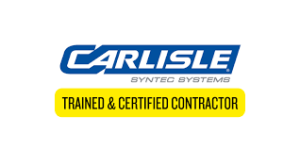Understanding Rubber and TPO Roofing Systems
When it comes to commercial roofing solutions, rubber and TPO (Thermoplastic Polyolefin) roofing systems have become increasingly popular choices for building owners throughout New England, including Cape Cod and the Islands. At Cran-Marsh Inc., we’ve installed countless rubber and TPO roofing systems over our 50+ years as a family-owned and operated business, watching these materials evolve into some of the most reliable options available today.
Rubber roofing, technically known as EPDM (Ethylene Propylene Diene Monomer), has been a staple in commercial roofing since the 1960s. This synthetic rubber membrane offers exceptional durability and weather resistance, making it particularly well-suited for the variable New England climate. TPO roofing, a newer technology that emerged in the 1990s, combines the weatherproofing benefits of rubber with enhanced energy efficiency through its white reflective surface.
 Certified Carlisle EPDM Installer
Certified Carlisle EPDM Installer
As a certified Carlisle EPDM roof installer, we bring proven expertise to flat and low-slope roofing systems. Carlisle’s EPDM (ethylene propylene diene monomer) membranes are known for their durability, energy efficiency, and long-term weather resistance—making them a top choice for commercial and residential applications. Our team is trained and authorized to install Carlisle systems to the highest standards, ensuring every project meets manufacturer guidelines and qualifies for extended warranty coverage. When you choose us, you’re getting industry-leading materials installed by trusted professionals.
Key Benefits and Performance Characteristics
Both rubber and TPO roofing systems offer distinct advantages that make them excellent choices for commercial properties in New England, Cape Cod & The Islands. EPDM rubber roofing provides superior resistance to ultraviolet radiation, ozone, and extreme temperature fluctuations. The material can expand and contract without cracking, maintaining its integrity through decades of seasonal changes. With proper installation and maintenance, EPDM roofing systems typically last 20-30 years, with some installations exceeding 40 years of service life.
TPO roofing brings additional benefits to the table, particularly in terms of energy efficiency. The white membrane reflects up to 87% of the sun’s rays, significantly reducing cooling costs during summer months. This reflective property can lower roof surface temperatures by as much as 50 degrees Fahrenheit compared to traditional dark roofing materials. Additionally, TPO membranes are heat-weldable, creating seamless connections that eliminate the need for adhesives or tapes at seams, resulting in a stronger, more reliable waterproof barrier.
Installation Process and Technical Specifications
Installing rubber or TPO roofing requires specialized knowledge and equipment that we’ve perfected through decades of experience. For EPDM installations, we begin with a thorough inspection and preparation of the roof deck, ensuring proper drainage and addressing any structural concerns. The rubber membrane, typically available in thicknesses ranging from 45 to 90 mils, is then either fully adhered, mechanically fastened, or ballasted depending on building specifications and local wind uplift requirements.
TPO installation follows a similar preparation process but differs in the attachment methods. We use hot-air welding equipment to create molecular bonds between membrane sheets, resulting in seams that are actually stronger than the membrane itself. This welding process requires precise temperature control and speed, typically operating at temperatures between 700-800 degrees Fahrenheit. Our certified installers undergo extensive training to master these techniques, ensuring every seam meets manufacturer specifications for warranty compliance.
Maintenance Requirements and Long-Term Value
One of the most appealing aspects of rubber and TPO roofing systems is their relatively low maintenance requirements. We recommend bi-annual inspections to check for:
- Membrane condition including any signs of weathering, punctures, or separation
- Seam integrity particularly around penetrations and perimeter edges
- Drainage functionality ensuring gutters and drains remain clear of debris
Regular maintenance extends the life of these roofing systems significantly. Simple repairs, when caught early, can prevent water infiltration and more extensive damage. Both EPDM and TPO membranes can be easily patched or repaired without requiring a full rubber roof replacement, making them cost-effective options for long-term building ownership.
Making the Right Choice for Your Building
Selecting between rubber and TPO roofing depends on several factors specific to your building and operational needs. EPDM remains an excellent choice for buildings where initial cost is a primary concern, as it typically costs 10-20% less than TPO. It’s also ideal for roofs with numerous penetrations or irregular shapes, as the flexible membrane conforms easily to complex geometries.
TPO becomes the preferred option when energy efficiency is paramount, particularly for buildings with high cooling loads or those pursuing LEED certification. The energy savings from TPO’s reflective properties often offset the higher initial investment within 5-7 years through reduced utility costs. As a GAF Master Elite certified contractor, we can help you analyze your specific situation to determine which system offers the best return on investment for your property.
 Certified Carlisle EPDM Installer
Certified Carlisle EPDM Installer
